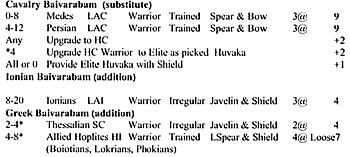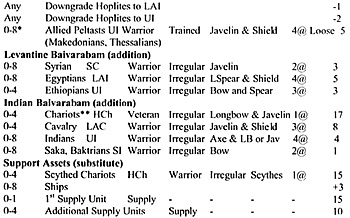With the consolidation of the Persian Empire at the end of the sixth century came challenges to its authority, especially in Egypt and Ionia. Mainland Greek support for the Ionian Greeks brought the empire into contact and conflict with Greece, initiating 150 years of practically uninterrupted conflict. Persian armies directly confronted Greek coalitions in the invasion campaigns of Darius I and Xerxes; furthermore, Persian foreign policy encouraged Greek fraternal warfare, and internal power struggles were often fought by proxy by the use of Greek mercenaries by both royalists and insurgents within the Persian Empire.
Sources, ancient (Greek) and modern (readers of Greek), frequently refer to the deficiency of the Persians in hand to hand combat. The interpretation here holds that that deficiency was clearly evident vis-à-vis the premier heavy infantry of the age, Greek hoplites, and it was manifestly due to a deficiency in unit tactics, rather than inferior weapons or equipment; the success of the hoplite cannot be attributed solely to the hoplon and a long spear. It may be asserted that an individual soldier of the Amrtaka was just as likely to be heavily armed and armoured as an individual Spartan hoplite, e.g., was likely to be naked (apart from helmet and hoplon). The essence of hoplite warfare may be found in the weight of the massed charge delivered by the many. As Aesop had it, unity gives strength.
The themes running through this list include the continuing improvement of the native Persian cavalry and the integration of new sources of manpower into the Persian military establishment, including mainland and Ionian Greeks, Egyptians, and Indians.
The following list is comprised of additions to, or substitutions for, baivarabam in the Rise of Persia list above; any baivarabam from above without a substitute below is carried over into this list without modification (each baivarabam below has a note indicating whether it is a substitute or a new addition to the prior list).
Army List
200 Stands/100,000


More Achaemenid Persians
-
Introduction
A Persian Primer
A Great Power Emerges 550 - 500BC
Attack on the West 500 - 400BC
Civil War 400-338BC
The End 338-329BC
Sparabara House Rule
Back to Saga #81 Table of Contents
Back to Saga List of Issues
Back to MagWeb Master Magazine List
© Copyright 2001 by Terry Gore
This article appears in MagWeb (Magazine Web) on the Internet World Wide Web. Other military history articles and gaming articles are available at http://www.magweb.com